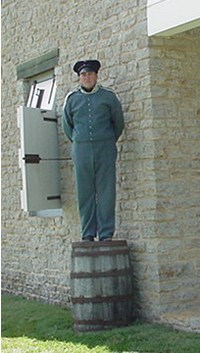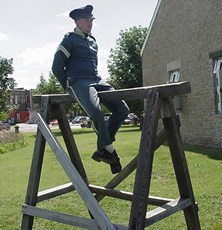
Discipline at any post of the 1800s was strict; punishments were harsh and often cruel. During the 1820s, according to a former soldier writing in 1845, the United States Army had, "acquired a very odious notoriety for the diabolically inhuman treatment of the enlisted men by their officers; and although laws existed, ostensibly for the protection of the rights of the former, yet the loose and inefficient manner of executing them had at length rendered them a mere farce." Men were kicked, cuffed, cursed, and even mauled without cause, as suited "the caprice or anger," of the officers. When the Commanding Officer of a regiment or post was a humane man, the men fared better at the hands of their officers than many of their fellow soldiers. Respect for the rank of commissioned and noncommissioned officers, regardless of the worthiness of the individual, was demanded unconditionally. Under no circumstance could an enlisted man overstep the line that separated him from his superiors. Post commanders dealt with gambling, drunkenness on duty, fighting, theft, embezzlement, desertion, and insubordination. Officers, aware of their prerogatives, summarily brought charges against soldiers for failure to salute, disrespectful language, failure to execute and obey orders, etc., and insubordination was not confined to the ranks but extended to the noncommissioned officers as well. Discipline became a particular problem at garrisons after payday, when the men had money in their pockets and could secure extra liquor. Very early, the Inspector General of the Army reported the effect liquor was having on the discipline of the soldiers. In 1830, in an attempt to curb the drunkenness, which formed an escape for many from the monotony of work and the harshness of frontier life, the gill of whiskey, which was allowed in the daily ration, was omitted. By 1845, attempts were made to prohibit drinking, even among the officers, at such posts as Fort Scott. Bored soldiers, however, had little trouble obtaining supplies of liquor one way or another. Once a soldier was under arrest, he was tried, depending upon his crime, either by a court-martial, composed of three officers, or by a general court-martial, consisting of five to eleven members. The small court tried minor cases and did not have jurisdiction over capital cases, officers, nor could inflict on any soldier a fine exceeding one month's pay, nor imprison or put to labor a soldier for longer time than one month. The general court-martial was convened for the more serious trials and had all the above jurisdiction. Although the character of the soldier was taken into consideration at his trial, the word of an officer usually was final regarding the guilt or innocence of a man. The following rare description of a military court proceeding is given as written in 1845 by a soldier, who obviously regarded the activity with prejudiced eyes: … It generally consists of three members (commissioned officers); one of them, usually the youngest in rank, is the recorder, and acts as Judge Advocate. Although the recorder is presumed to have an eye to the interests of the prisoner as well as those of the government, yet in six cases out of seven he does not appear to recognize that prisoner can have any interests to be jeopardized. The advocate asks the prisoner, whether he objects to any member of the court. And if he does object, he is required to give good and sufficient reasons for such objection. Instances of such objection are not infrequent; but in almost every one, the members of the court find it convenient to deem the reasons for such objection not good and sufficient. He has the privilege of calling any witnesses in his defense, but if the witnesses are privates they are generally so overawed by the haughty, arrogant bearing of the court, as to be of little service to him. The prisoner is not allowed to speak in his defense, but can address the court through the advocate, or reduce to writing what he may desire to offer in his defense, and present that to the court. After trial, the prisoner is sent back to the guardhouse, and the sentence of acquittal in his case is in due time read to him by the officer of the guard… On the morning after the trial, the prisoners were all paraded on the left flank of the guard, in front of the guardhouse, while the officer proceeded to read the proceedings of the court in the cases of those prisoners who had been tried. A trial of this kind applied to enlisted men. From Recollections of the United States Army, published in Boston in 1845 Only the Commanding Officer had the power to place officers under arrest, except for offenses expressly designated by the 27th Article of War. Officers, of course, were not confined in the guardhouse; although, they could be restricted to their quarters. "An expression of disapprobation" by the Commanding Officer was considered sufficient "in most cases" to discipline an officer. 
Punishments of the period varied. Punishments handed out ranged from reduction in rank, stoppage of pay, and confinement in the guardhouse for minor offenses to "bucking and gagging," "spread eagle," standing on a barrel with a sign that read "I stand for _________," confinement in a choke box or the solitary cells, mounting the wooden horse, and even wearing iron collars or balls and chains. Whipping was common. Discontent with army life bred desertion. Punishments for deserters could include being stripped of insignias, branded with a "D," drummed out of their regiment, and sent out into the surrounding country to find their way home as best they could. At Fort Scott, it was more common to sentence deserters to hard labor, stoppage of pay, and imprisonment in the guardhouse. Historic Furnishing Report for The Guardhouse at Fort Scott, written by Sally Johnson Ketcham. |
Last updated: July 25, 2016

